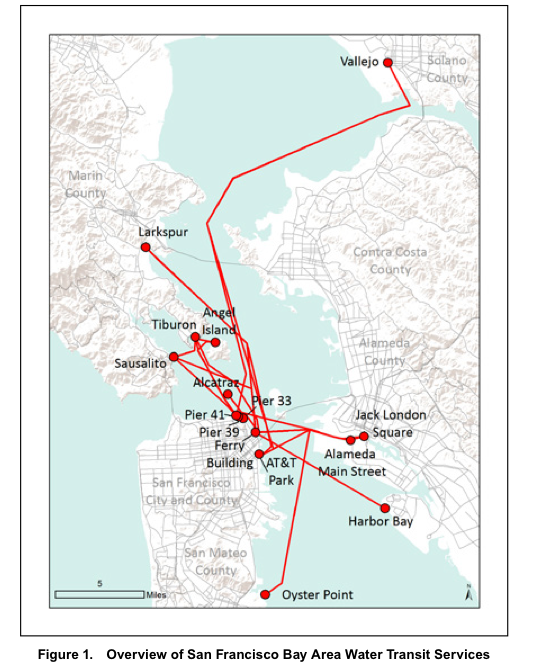MINETA TRANSPORTATION INSTITUTE
Executive Summary
This study provides a comprehensive assessment of current ferry operations in the state of California. this work was conducted to assist the California Department of transportation (Caltrans) comply with requirements in the federal MAP-21 legislation (the Moving Ahead for Progress in the 21st Century Act). MAP-21 is the first multi-year transportation authorization enacted since 2005 and funds surface transportation programs at over $105 billion for fiscal years 2013 and 2014. The Caltrans Division of Local Assistance has been asked by the Federal Highway Administration (FHWA) to gather data regarding ferry operations under MAP-21 since the Act includes a new formula program for ferry boats and ferry terminal facilities eligible under 23 USC 129(c) which authorizes federal participation in toll roads, bridges, tunnels, and ferries. FHWA has asked that Caltrans assure the ferry data is current for MAp-21.
Our first task was to develop a complete listing of all ferry operators in the state. The research revealed that water transit vessels in California provide services beyond what is commonly considered to be traditional “ferry” operations, and this necessitated the creation of three primary classifications of water transit service: commuter, non-commuter, and recreational/”circular”. Broadly speaking:
- Commuter services are commonly understood as “ferries” and provide essential, “point A to point B” transportation such as traditional vehicle or passenger ferries.
- Non-commuter services also provide “point A to point B” operations but provide a variety of connecting services beyond those that are essential for vehicle and passenger commuting purposes.
- Recreational/“circular” services begin and end at the same terminal and include services such as dinner cruises or sport fishing operations. We have included these services in order to capture a wider array of water transportation vessels.
During our research we also learned of a number of “water taxis,” small vessels that transport passengers on either a fixed-route or non-fixed route basis for short-distance trips. Since water taxis can provide commuter and/or non-commuter services, we have integrated them into the appropriate classifications wherever relevant. Table 1 provides a summary of the commuter and non-commuter water transit services in California organized by region listed at the left. Note that the table is as complete as possible through November 2012, considering that a small number of operators were not forthcoming with needed data.
Figure 1 presents an overview of water transit services operating in the San Francisco Bay Area. this regional section concludes with water taxi services in Santa Cruz, although those services are not reflected in Figure 1 in order to maintain a detailed geographic focus; however, the poster map in the back pocket of this report does show the Santa Cruz area services.
Read full report (PDF) here: 2012 Census of California Water Transit Services
About Mineta Transportation Institute
transweb.sjsu.edu
“The Mineta Transportation Institute (MTI) conducts research, education, and information and technology transfer, focusing on multimodal surface transportation policy and management issues. It was established by Congress in 1991 as part of the Intermodal Surface Transportation Efficiency Act (ISTEA) and was reauthorized under TEA-21 and again under SAFETEA-LU. The Institute is funded by Congress through the US Department of Transportation’s (DOT) Research and Innovative Technology Administration, by the California Legislature through the Department of Transportation (Caltrans), and by other public and private grants and donations, including grants from the US Department of Homeland Security. DOT selected MTI as a National Center of Excellence following competitions in 2002 and 2006. The internationally respected members of the MTI Board of Trustees represent all major surface transportation modes. MTI’s focus on policy and management resulted from the Board’s assessment of the transportation industry’s unmet needs. That led directly to choosing the José State University College of Business as the Institute’s home.”
Tags: CA, California, Caltrans, Federal Highway Administration, FHWA, MAP-21, Mineta Transportation Institute







 RSS Feed
RSS Feed